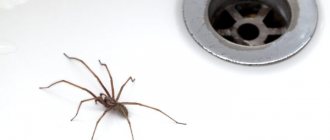You can watch a spider's meal for a long time. Feeding spiders is a truly fascinating spectacle. Seeing the victim, the spider rushes at it and instantly injects poison into the body. The poison immobilizes the prey, and the spider, slowly weaving it with a web, releases gastric juice into the prey and begins to eat. The feeding of spiders turns into a whole performance. But what should you feed a regular spider to ensure its long existence? How is feeding a tarantula spider different? To understand what to feed a spider at home, you need to understand what constitutes the diet of arthropods in their natural habitat.
What do spiders eat in the apartment?
Exotic pets eat everything they eat in the wild. The owners give their charges various insects, scale insects, snails, caterpillars, as well as small vertebrates, reptiles, and amphibians. Large animals are fed rodents.
House spiders, which make their way into a room through open windows, doors, cracks in the wall, eat cockroaches, flies, fruit flies, mosquitoes, moth caterpillars, an accidentally flown butterfly, wasp, and bee. There are many arachnids in houses with complete unsanitary conditions and many pests. Small spiders eat all the living creatures that are in the apartment.
What spiders can eat depends directly on their own size. Small predatory individuals choose fruit flies, mosquitoes, and caterpillars. A medium-sized arthropod can only feed on insects - it catches flies, bees, and wasps. If too large a victim gets entangled in the web, the spider frees it. The same applies to bedbugs, since they emit an unpleasant odor in self-defense.
Is it necessary to exterminate arthropods?
Corners, windows and ceilings covered with cobwebs look untidy. If there are a lot of spiders in the house, it means that the cleaning there is carried out poorly, with hard-to-reach places being ignored. That is why the answer to the question of whether it is necessary to look for a remedy for spiders is in the affirmative. It is possible and necessary to fight arthropods, but it is better to do it humanely, especially if the goal is not to harm living beings.
The most humane method is to remove the spider from the house mechanically. Arthropods are manually collected in a jar or on a scoop, taken away from the house, and the cleanliness of the house is monitored, preventing their further appearance.
Spiders hibernate outdoors under leaves, in warm corners behind the bark of trees, so you can release them from your home at any time of the year.
How does a spider kill its victims?
Arachnids differ somewhat in their lifestyle, behavior, and hunting tactics.
- Animals weave trapping nets and wait for their prey in the center of their creation or in the immediate vicinity. The presence of insects is determined by vibrations.
- They actively search for a victim, exploring the surrounding area. They attack at the right moment.
- Some spiders do not weave trapping webs, but construct the web in the form of a funnel near the burrow or shelter.
Food for spiders
Predators also behave differently - they entangle prey with their threads, leave them for a while, and begin to feed on insects almost instantly. However, initially predators act identically with their victims - they inject a toxic substance.
All spiders have poisonous glands; they kill insects and small vertebrates with chelicerae, which are located in front of the cephalothorax in the form of fangs. A poison with a paralyzing effect, one’s own saliva, is injected into the wound, which turns the insides into a liquid mass.
It takes 5 to 15 minutes for the prey to become usable. All this time, the predator watches the insects, sitting to the side. When the body stops convulsing, the meal begins.
Internal structure of arachnids
The respiratory system of the cross spider is represented by pulmonary sacs and trachea. The pulmonary sacs and trachea of arachnids open outwards with special openings on the lateral parts of the segments. The pulmonary sacs contain numerous leaf-shaped folds in which blood capillaries pass.
The trachea is a system of branched tubes that connect directly to all organs where tissue gas exchange takes place.
The circulatory system of arachnids consists of a heart located on the dorsal side of the abdomen and a vessel through which blood moves from the heart to the front of the body. Since the circulatory system is not closed, blood returns to the heart from the mixed body cavity (mixocoel), where it washes the lung sacs and trachea and is enriched with oxygen.
- 37 facts about cheetahs
- Scolopendra
- 32 facts about tigers
- Weasel
- Whale shark
- 34 facts about raccoons
The excretory system of the cross spider consists of several pairs of tubes (Malpighian vessels) located in the body cavity. Of these, waste products enter the posterior intestine.
The nervous system of arachnids is characterized by the fusion of nerve ganglia with each other. In spiders, the entire nerve chain merges into one cephalothoracic ganglion. The organ of touch is the hairs covering the limbs. The organ of vision is 4 pairs of simple eyes.
How do domestic and wild spiders feed?
Arachnids do not have complete digestive organs. The food is digested from the outside, after which the arthropod absorbs the liquid mass through the mouth. There are no teeth in the mouth either. Chelicerae and pedipalps, similar to tentacles, help crush and grind food. Some spiders are only able to suck up liquid food, while others crush the shell and bite through the skin. The pigtail eats the victim entirely.
Amphibians and rodents take longer to digest. The predator eats a mouse, snake, or frog gradually, turning it in different directions, constantly injecting a new portion of saliva. You can see how spiders eat flies in the video below.
The predator's diet depends on its habitat. An arthropod can go without food for about a month. If there are a large number of insects, it feeds once every 7-10 days. Some members of the family are so “greedy” that they do not crawl to the side until they leave only a shell or an empty space from the victim. In other cases, they leave the prey in reserve.
Curious racers
Jumping spiders are also jumping spiders that are not dangerous to people, of which there are 6,000 known species. The body of the spiders is only 1 cm, with a flattened abdomen, raised cephalothorax and strong legs. The spider looks with 8 eyes arranged in three rows. The body and pattern are both light and dark in color.
Habitat: trees and shrubs; they appear randomly in apartments; they are able to move on glass surfaces.
They prefer to hunt in the daytime and without cobwebs. Interestingly, the female, having laid her eggs in a cocoon, guards the clutch until the babies appear. Then he grooms and brings food until the molt has passed. After this, the cubs run away to live on their own.
Where do spiders go in winter?
Arthropods adapt to the onset of cold weather in different ways. Spiders are unable to tolerate temperatures below 0 degrees due to tissue crystallization. Depending on this, spiders can sleep or die in winter.
Young cross spiders and “newborn” wasp spiders migrate on wind-blown spider webs in search of habitat on warm September days. Huddled in a crack in the bark of a tree, spiders sleep in winter.
Sexually mature parents of baby wasps end their life in the summer: the male - in the form of a “wife” dinner after mating, the female - after laying eggs. A similar situation occurs in adult crosses. Autumn is the mating season, when males go in search of females sitting in their web. After fertilization of the female, the male dies. The spider weaves a cocoon in which it lays eggs. Having hidden it in a secluded place (in the bark of trees, cracks in masonry), it also dies. In the spring, spiderlings emerge from the eggs, ready to weave webs.
Males and females of black widows do not survive until the cold weather. At the end of June, mating occurs, after which the female eats the “suitor”. Having laid up to 130 eggs in prepared cocoons, she hides them in lairs (mouse holes, crevices) entwined with dense cobwebs and dies. Spiders appear in September and live in a cocoon until April, eating each other. With the onset of stable heat, they go outside.
As for the species of black widows, spiders that were born in September spend the winter with them. In a warm cocoon left by a caring spider mother, they sleep until April. Spreading in search of habitats, they have arachnoid and venom-carrying apparatus. During mating at the end of June, the female karakurt eats the male. After laying eggs it dies.
Domestic arthropods may go into torpor with the onset of winter if the number of indoor parasites decreases sharply. Waking up before the onset of spring, they can feed on their relatives.
Rare species live in burrows and crevices
Predatory arthropods, whose life cycle exceeds a year, fall into torpor with the onset of cold weather. Species such as tarantulas live in the wild for 5 to 10 years. Helping them survive is the ability to go without food for a long time and the mild climate in their habitats. With the onset of cold weather, they burrow into their vertical burrows and hibernate until spring.
The edge hunter has a life expectancy of 2 years, until the age of mating. After breeding, they die in August. Immature individuals spend two winters in the mother's cocoon, attached to the grass on the shore, in a state of torpor.
Silverback spiders build their winter cocoons underwater
During the cold season, when rivers and lakes are frozen, the silverfish prepares winter housing. The spider controls the volume of the bell and the oxygen content in it. The air supply in such a cocoon is enough for 4-5 months. Nearby, the silverfish weaves the second and third mesh networks and fills them with air. This insurance allows you to overwinter without rising to the surface until warm days arrive.
Hiding in a mollusk shell
If there is no algae and nowhere to go, the water spider can use an abandoned mollusk shell instead of a cocoon. He fills it with air bubbles from the surface and covers it with thick nets instead of curtains. Such a house serves as reliable protection from large fish and crayfish.
They overwinter with young offspring (the female is eaten in the spring)
The black fathead spends its winter in a special way. With the onset of autumn, the mating period approaches, and the males go in search of females. Having carried out the necessary fertilization ritual, the male remains to live in the same burrow with the female. The fathead spider makes a cocoon for its offspring, where it soon lays eggs.
For 2 months, spiders guard the clutch in a cocoon. With the onset of spring, spiders appear. Spiders serve as food for them. By the end of summer there are 3 molts. Young spiders crawl out of their holes to find a home. After 2 moults they will become sexually mature and will look for a female. A male spider, whose life cycle is less than a year, dies by this time.
Predator's net
When hearing the word “spider,” a person immediately imagines an openwork web or dense snares. The spider weaves a web using a solidifying liquid substance found in the arachnoid glands located inside the abdomen. A sticky mass is released from arachnoid warts. The threads of the web woven by a spider are thin webs glued together from several different glands.
Spiders use webs:
- for catching prey;
- for creating a cocoon around the masonry;
- burrowing spiders line their dug-out dwellings with soft webs;
- In the autumn, young spiders use long threads from the web for migration.
What do they eat in winter?
Most spiders cannot eat their food right away. The venomous bite is necessary to paralyze the victim and turn its insides into a nutritional cocktail. The peculiarity of spider physiology does not require maintaining a constant temperature. For this reason, they can go without food for a long time and fall asleep, falling into torpor. During the winter months, the food supply is maintained by water and house spiders.
What do house spiders eat in an apartment in winter? Flies and mosquitoes stop penetrating into human housing with the onset of cold weather, going into hibernation. But apartments can be inhabited by cockroaches, moths, and fruit flies. Predators eat each other, thus redistributing habitat areas. The life cycle of house spiders is short: from 2 to 6 months. Reproduction depends on the food supply: if it is insufficient, new offspring appear after the end of the life cycle of the parents.
Haymakers
Haymakers, also known as centipedes, also known as window spiders, are red or brown house spiders, with a small 1 cm dark abdomen and long 5 cm legs. They weave cobwebs into the corners of rooms and love to bask where the sun warms them.
The haymaker is not dangerous for people - it will attack only if frightened, but more often it runs away. They enter houses during cold spells at night. In summer and autumn, the female lays eggs and entangles them in a web. After 14-20 days, light-colored small spiders emerge.
A damp spring cleaning will help drive out unwanted tenants.
Requirements for setting up a terrarium for a tarantula
— the terrarium should provide space for the spiders. The surface of the walls for arboreal species and the surface of the bottom for terrestrial ones should be no shorter than 2 times the span of the spider's legs in maximum amplitude. At the same time, the excessive space of the terrarium creates difficulties in constantly maintaining optimal temperature and humidity; in such a terrarium it is difficult for spiders to find food. - the terrarium must be safe - for the owners and for the spider itself. The possibility of escape must be completely eliminated, and the possibility of a spider bite and attack must also be minimized. You may find it helpful to read about the Poecilotheria fasciata bite. — containers with a high height cannot be used for ground spiders, because the tarantula can fall from a height and get a ruptured abdomen. For arboreal spider species, the height of the terrarium is an important component of success in keeping them. Large stones should not be placed near such spiders to prevent spider strikes and subsequent damage. — a good ventilation system is necessary for all types of terrariums. — as a shelter for terrestrial tarantulas, you need to install in the terrarium either a piece of bark, or half of a flower pot, or some kind of artificial shelter. For tree spiders, a shelter in a terrarium can be built from a piece of pine or oak bark. By and large, tarantula spiders do not necessarily need to be kept in terrariums; any food containers or standard insect boxes are suitable for them. The main thing is that these containers must meet the above conditions. And newborn baby spiders feel great in small plastic boxes, such as those made for photographic film, with small-diameter holes on the lid and sides. As the spider grows, it is transplanted into larger jars.
Dream Interpretation – Leather
Seeing leather as a material in a dream portends strengthening friendship and prosperity in love. Pieces and scraps of skin piled up in a heap portend good luck and happiness. Processing leather in a dream means no changes in the course of your business, tanning it is a residue from an unpleasant meeting, sewing something from it means accumulating wealth through frugality.
Leather clothing on someone is good luck in the game and in everything related to money. Being dressed in leather means you will be lucky in love. Seeing suede products in a dream means your charms will conquer any man. Safyan portends help from unexpected sources. Black or dirty skin is a sign of adultery. Cleaning or washing the skin means illness of loved ones.
If in a dream you focus your attention on human skin without any flaws, clean and beautiful, this means that in real life you will be the object of adoration of a prominent man. Smooth and silky skin to the touch - to the fulfillment of desires regarding the creative side of life. Old, loose and wrinkled skin indicates that you will safely reach old age
Sick skin - to wealth; skin with scratches, bruises and scars - to ill-gotten money. Torn and bleeding skin - to a rich groom and an imminent wedding. Being treated for skin diseases in a dream promises health and profit.
Old, loose and wrinkled skin indicates that you will safely reach old age. Sick skin - to wealth; skin with scratches, bruises and scars - to ill-gotten money. Torn and bleeding skin - to a rich groom and an imminent wedding. Being treated for skin diseases in a dream promises health and profit.
Seeing a blister from a burn on the skin is a sign of unexpected events in your personal life. An abscess on the skin means drinking in a fun company; boils mean trouble in the near future, insincerity of friends who are hiding something from you. Sores on the skin mean that the disease will undermine your strength and bring mental exhaustion.
Seeing skin worn away by leprosy means doing something that will bring concern not only to you personally, but to your entire family. Skin covered with a rash from scabies is a sign of fear of failure in a business that you have never done before. Scratching your skin to the point of ulcers, experiencing unbearable itching, means that in reality you will find yourself in bad company and get into a lot of trouble.
Seeing skin completely covered with moles means an addition to the family. A large birthmark on the skin portends twins. The skin of your face or hands dotted with freckles means you will experience a funny adventure in reality. Tanned skin means you will have a successful vacation; white and pale skin means frustration from an insult caused by a loved one. Seeing your skin as black as a black woman’s means that in real life you will be mistaken for someone else.
It personifies the parasitic influence on someone’s part or one’s own vampiric aspirations to capture the victim. Fighting a spider means conflicts with superiors or opposition to the mother’s care. Holding a spider in your hands means receiving a gift. The web is an invisible trap. The symbolic meaning of this creature is associated with the web with which he weaves the world.
Since the web of life and fate is woven by the divine spider, it is perceived as a kind of universal given, the grip of existence. In mythology, the universal mother is depicted in the form of a spider, as a weaver of fate. In dreams, a spider can indicate its own domineering mother or someone’s vampiric presence , forcing you to act according to a plan alien to you.
Notes
- ↑ 123
- ↑
- ↑
- ↑ 12345
- ↑ 12
- ↑
- ↑ 123
- ↑
- ↑ Cooke, J. A. L., Roth, V. D., Miller, F. H. (1972). The urticating hairs of theraphosid spiders. American Museum novitates 2498. —
- ↑ Blaikie, Andrew J; John Ellis, Roshini Sanders, Caroline J. MacEwen (24 May 1997). "". BMJ314(7093):1524–5. DOI:. . Retrieved 2007-03-06.
- ↑. Tarantupedia.
- ↑ R. Bertani, C.S. Fukushima, PIS Júnior (2008). Mating behavior of Sickius longibulbi (Araneae, Theraphosidae, Ischnocolinae), a spider that lacks spermathecae. The Journal of Arachnology 36:331–335.
- ↑ RC Gallon (2003). A new African arboreal genus and species of theraphosid spider (Araneae, Theraphosidae, Stromatopelminae) which lacks spermathecae. The Bulletin of the British Arachnological Society 12 (9), 405–411.
- ↑
- ↑
- ↑
- ↑ Stanley A. Schultz and Marguerite J. Schultz, The Tarantula Keeper's Guide, p. 75
- ↑
Industrial chemicals
On the shelves of specialized stores you can see a wide range of insect and spider repellents. For apartments and any other living space, it is better to choose gentle sprays or gels, while for the surrounding area of private houses it is much more practical to use aggressive chemicals.
You need to understand that spiders settle exclusively in places where there is food: mosquitoes, flies, wasps and other insects. First of all, it is necessary to get rid of the cause and only then take on the effect.
Let's consider the most popular and well-proven industrial products that have received many flattering reviews from consumers.
Raid
The most effective aerosols are produced under this brand. Experts recommend using the “From Ants and Cockroaches” series. The product acts instantly and allows you to destroy the spider in just a few seconds.
In addition, Raid has a long residual effect. Having sprayed the problem area once, the next treatment can be carried out a month later. This way you can get rid of the annoying neighborhood forever. After spraying, the aerosol does not smell and does not contain harmful petroleum products, which is the problem with inexpensive analogues.
The manufacturer recommends using Raid indoors, after moving children and pets to another place. After treatment, you must wait until the product dries and only then allow household members and pets into the room. Due to its high efficiency, the cost of the aerosol is at an appropriate level.
Joker Bun
This is a Turkish household product in aerosol format without a pronounced odor. Joker Bun does an excellent job of eliminating all crawling and flying insects, including representatives of the arthropod order. The aerosol does not cause pronounced allergic reactions upon contact with skin, so it can be recommended for allergy sufferers.
The product cannot be used in kitchens near unprotected food, as well as in catering establishments. The manufacturer also recommends removing children and pets from the premises before using the aerosol. The spray works very quickly. A few seconds after application, the spider loses the ability to navigate and dies a couple of minutes later.
When applied to spiders, Joker Bun should be sprayed along baseboards, over large furnishings, corners, window sills and openings, as well as service and ventilation openings in bathrooms, kitchens and other rooms, if there are any.
Raptor
"Raptor" in aerosol format received a lot of positive reviews. Besides the fact that it is inexpensive, it is also in no way inferior in efficiency to foreign analogues. One cylinder is more than enough to treat rooms with a total area of 60 square meters. m.
The product acts quickly enough and maintains the effect for at least a month.
Raptor contains aggressive chemicals, so it should be used with extreme caution in apartments where children and exotic pets live. After treatment, the room must be thoroughly ventilated for at least one hour.
Judging by consumer reviews, the substances included in Raptor can provoke allergic reactions. So allergy sufferers should take a closer look at the above-mentioned remedies. They are noticeably more expensive, but more balanced in this regard.
Prevention measures
Most owners do not want to put up with spiders in the house. One multi-legged “alien” is most likely good news, but a lot of arachnids scurrying around the apartment, suddenly appearing before your eyes, is annoying and frightening.
Cleanliness of the apartment, absence of trash, regular cleaning of all rooms and areas are the basic rules, if followed, an invasion of spiders will definitely not happen. Even during abnormally warm years, when too many arachnids breed, a spacious apartment in which order reigns will be free from “decorations” in the form of trapping nets.
Even if the owners are kind to spiders, they believe that “neighbors” who weave trapping webs cannot be killed, and it is not worth keeping arachnids in corners and closets. Houses and apartments are places where people live, not eight-legged arthropods. Each owner chooses at his own discretion methods of combating arachnids.
Find out more interesting details about spiders in the house from the following video:
Types of web
There are several types of different webs in the world. They are:
- Round . The most common. It has a minimum number of threads. Because of this weaving, it is hardly noticeable, but it is not perfectly elastic every time. Radical threads-webs emanate from its center, which are connected by spirals with a sticky base.
- Cone-shaped . Basically, the funnel spider weaves it in tall grass, and, waiting for prey, it hides in its narrow base.
- Zigzag.
- Gigantic . Its dimensions vary from 900 to 28 thousand square centimeters.
Cockroach
Domestic cockroaches are the most unpleasant insects that can be found in the house. Scientists claim that they are carriers of infectious diseases that affect the functioning of the intestinal tract. Pests can appear in every housewife, even the cleanest ones; they can sneak into the apartment from neighbors who are undertaking renovations.
Cockroaches feed on everything: food, waste, paper, fabric and much more. They can fast for about two weeks. Not finding food in the house, which is unlikely, they run to the next apartment.
The harm that cockroaches bring to humans:
- They are carriers of infectious diseases.
- They spoil things, get into equipment, feed on wallpaper and paper bindings.
- They can get tangled in the wires and a short circuit may occur, resulting in a fire.
- May cause allergies.
Pests multiply quickly, so experts recommend taking immediate action to destroy them. Pests can be controlled using folk, mechanical and chemical means. The most effective means are chemicals.
- Treat the apartment with a solution of water and vinegar.
- Cockroach crayons. This drug is ineffective in fighting insects, but is not very toxic and is safe for humans.
- Sprays and aerosols. A product with high toxicity, which is not very good for humans. When using an aerosol, do not forget about your own safety; handle the room with gloves and gauze masks.
- Traps. Small and poisonous inside.
- Alcohol. Wipe or spray with ammonia all places in the house where pests live.
- Smoke bombs. The most effective means of pest control and the most dangerous for humans. Smoke is highly toxic. When treating the premises yourself, do not forget about your health and precautions.











